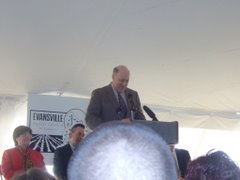Tuesday, February 19, 2013
Mailbag: Vinehout: On Mining Jobs
How Good Are Claims About Metal Mining Jobs?
“We have the potential for a billion and a half dollar investment,” said Governor Walker in his recent State of the State speech. “That could lead to as many as 3,000 construction-related jobs and 2,800 long-term jobs.”
I wondered, “Just how sure are we all these jobs will happen?”
I started to dig through the mounds of paperwork related to the proposed iron ore mine in Northern Wisconsin. It turns out the claim of jobs is related to one 28 page document: an economic impact study by NorthStar Economics. Unlike other reports by NorthStar, there is no author’s name and no client’s name on the title page.
As I read the report, I could hear my high school mathematics teacher telling me, “Show me how you got the results.” The problem was the details needed to check the results were missing.
Most of the report had little to do with the actual math used to make the calculations on the number of jobs created.
Nine pages described the economy of the 12 county region in Northern Wisconsin and Michigan. Five pages repeated what another study said about mining in Minnesota and Michigan. One page each described the purpose and scope of the report; definition of terms; executive summary and conclusion (almost word for word the same as the executive summary).
That left ten pages for the analysis. These ten pages were made up almost entirely of assertions about dollars and jobs without any supporting evidence.
There were only two sentences that described the basis for the author’s assertions. There was no basis on which one can evaluate the author’s assumptions, methodology or accuracy.
The study said the majority of jobs to be created by the mine are in transportation. We are not told, however, whether this estimate is based on ship, rail or truck transport, or some combination, or the destination, or how this might affect the communities through which the ore will be transported.
Even though NorthStar advertises its capability of pinpointing jobs by legislative district on its website, the mining report is careful to not say any more about where the benefits of the mine would occur except they would “primarily impact” the 12 county region in northern Wisconsin and Michigan.
A more sobering picture of the economic effects of mining on rural communities is painted in a 2002 academic article written by a professor with a joint appointment at UW-Madison and University of California – Santa Barbara, and a researcher at the Watershed Research and Training Center. The authors reviewed all the published economic research studies they could find about the impact of mining on jobs, income and unemployment rates in rural communities.
The authors described their methodology and assumptions in great detail and found that mining, rather than being a boon to rural communities, was more likely to be associated with lower incomes and more unemployment.
They write:
“There is a potentially telling contrast in two types of studies that have gauged the reactions of local leaders. In regions that are expecting increased mining or just beginning to experience a ‘boom,’ it is common to find what Gulliford calls ‘euphoria.’ Unfortunately, in regions that have actually experienced natural resource extraction, local leaders have been found to view their economic prospects less in terms of jubilation than of desperation.”
“Despite the widespread expectation that mining will lower local unemployment rates, actual findings of such favorable conditions prove to be relatively rare.”
The authors also point to evidence that the higher salaries of mine workers are often not captured by local residents, but go to out-of-area workers.
The authors conclude:
“To the extent to which past experience is to be our guide, there is surprisingly little evidence that mining will bring about economic good times, while there is a good deal of evidence for expecting just the opposite.”
What are we to believe? After reading both documents, placing them side-by-side, I concluded that the more sobering analysis was the more convincing. They showed me how they got to their results.
If you know someone who would like to be added to this distribution list, please let us know.
If you wish to unsubscribe from this newsletter, reply with "Unsubscribe" in the subject line
Sen.Vinehout@legis.wisconsin.gov State Capitol Room 316 South - P.O. Box 7882, Madison, WI 53707-7882 Toll Free: (877) 763-6636 or
Subscribe to:
Post Comments (Atom)






























No comments:
Post a Comment